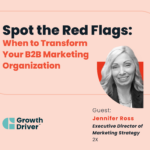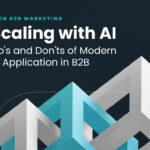In every CMO, VP, or Director of any corporation, an invisible question is becoming more distinct by the second, “Are you truly customer-obsessed?” Coined by Forrester, ‘Customer Obsession’ is more than a first-class, highly curated buyer experience–it’s putting them at the center of every aspect of leadership strategy and operations.
In reality, truly being customer obsessed requires a single-minded focus of offering them value, and taking your own opinions out of the discussion altogether. This is not one-size fits all, and not fit for all companies. But for those of us that are, it’s cyclical. Defined by consistency, empowered by technology, and fueled with human insight that pieces together the jigsaw of customer experience in a way that always prioritizes the customer’s reality.
Defining customer obsession
The B2B landscape is shaded by decision-makers who seem far removed from the final user. Now more than ever, it seems organizations have lost sight of why they exist. Simply stated, it’s putting your customer at the center of everything you do.
Whenever you get to any decision point, refer back and ask, “How is the customer involved in this conversation? How does the result of this decision benefit the buyer?” Businesses exist to create value for key buyers, and customer obsession is the best means to get there; versus extracting value from buyers and forgetting about the opportunity to create it for the entire market.
Companies that grow rapidly and get really big really fast, they think about the world they exist in. They don’t think of themselves as a product that solves a problem. They think of themselves as a problem that needs a solution.
Only some need to be fully customer obsessed
These levels of customer obsession are not right for everyone because some companies don’t necessarily need to become fully customer obsessed the way that we would define it. It depends on how empowered your customers are.
If your customers are highly empowered, there’s a lot of self service buying and there’s a lot of choice in the market and they can do whatever they want; you’d better be customer obsessed because you’ve got to know every nuance of how they buy, what makes them tick, how they make decisions, and how much money they have. You’ve got to know everything. So be customer obsessed.
If your customers aren’t very empowered, if you have a monopoly and the only way that they’re going to get your solution is through you, it’s okay to be customer aware or customer committed. The power company doesn’t need to be customer obsessed, they already control the market.
The key to actually becoming customer obsessed
To achieve this level of nuance takes more than deploying CRM systems. It’s about creating customer DNA—predictive analysis and hyper-personalization to become the medium of customer narrative rather than the message. But without a C-level executive responsible for making sure that the customer is considered first in all decisions and operations, old habits resurface and decisions are made in disconnect.
This customer-champion could be an existing C role or one that is newly designated with the task, but it cannot be loosely applied. Especially at scale and within large companies, there’s an enormous amount of data about customers and what they want, believe, and need. It’s going to take a lot of data and that data has to have some meaning, but more importantly, all the senior leaders have to know how to interpret and make decisions with data because on some level.
You can’t just be piling on customer data without any way to turn that into actionable operations and strategies. If you’re not a data driven company or you’re not a data innovator, it’s hard to be customer obsessed at scale.
Staying grounded amidst demands for growth
With transparency comes trust, and customer obsession thrives on both. It’s about being transparent in your motives, in your stances, in your product roadmaps, in your successes, and especially in your failures. It’s about letting the customer in on the story so the two stories can entwine.
To truly achieve scalable, sustainable growth in today’s B2B environment, we cannot forget the very reason we exist. Amidst all the complexities and urgencies B2B leaders face trying to hit their growth goals, there is one grounding factor that can always be turned to: the customer.



